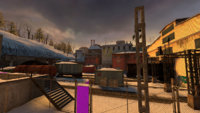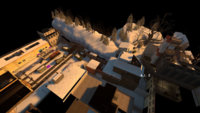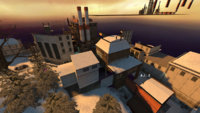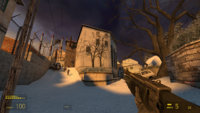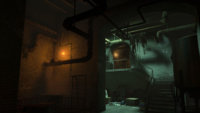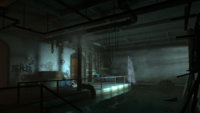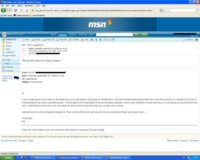In a recent email conversation, the former writer of the Half-Life series Marc Laidlaw confirmed that the cancelled Junction Point Studios' Half-Life 2 episode and Arkane Studios' Return to Ravenholm were the same project. According to Laidlaw, Gabe Newell offered the idea to Warren Spector first. When they couldn't do it, it was passed along to Arkane Studios who started again from scratch. Neither of these attempts got far enough to develop a story.
In Half-Life 2, Ravenholm is depicted as a dark and dreary zombie-infested town with a series of claustrophobic streets, teetering buildings, and an oppressive sky. Before the events of the game, it was an old mining settlement inhabited by refugees from City 17 until the Combine discovered and bombarded it with Headcrab Shells. The only survivor of the attack is the pastor of the town's church, Father Grigori, who helps the player throughout the chapter.
Introduction
In the May 2006 issue of PC Gamer (US) magazine, there is an interview with Gabe Newell in which he talks about the future of the Half-Life series and episodic gaming. In this interview, Newell revealed that there was going to be a fourth Half-Life 2 episode with its own standalone plot developed outside of the company. Much later, in an email conversation from September of 2008, Newell declared that this specific project was no longer going to happen.
Junction Point Studios
In November of 2004, game industry veterans Warren Spector and Art Min left Ion Storm to form Junction Point Studios, an independent video game development company. During this era, they spent much of their time on conceptualizing ideas and trying to find funding partners until the company was acquired by Disney in July of 2007.[1]
In December of 2005, the company announced they were working with Valve on a new game using the Source Engine to be delivered via Valve's digital distribution platform, Steam. This was later revealed to be a cancelled Half-Life 2 episode. The company had a previous project that was cancelled, leaving them with no remaining funds. Valve stepped in and saved them by offering them the opportunity to work on a Half-Life spin off.
The game was to introduce a new weapon called the Magnet Gun which went through several iterations. In one version, the player was able to fire a sticky magnetic ball at a remote surface that would attract metal objects, a twist on the Gravity Gun's mechanics. It had both combat and puzzle solving applications.[2]
On March 24, 2017, a Facepunch Forums member leaked map files created for the Half-Life 2 episodes. This pack also included "styleguide_ravenholm_01", a snow-themed Ravenholm level with references to Spector's Half-Life work. In this map, the Combine attacks a group of rebels residing in the town. The player would wake up in a room with two unique characters named Duncan and Scooter. It is implied that the player crashes into a warehouse in a gondola lift. You can check out the attached text file below for further information.
In the November 2017 issue of PC Gamer (UK) magazine, Spector confirmed that the game was to take place in Ravenholm to tell the story of how the town became as it was in Half-Life 2, an aspect that he believed was underdeveloped and that fans would really enjoy. In addition to fleshing out the setting, they wanted to see more of Father Grigori and the origins behind his character.
According to Spector, the company had just figured out how to use the Source engine and get the most out of it when Valve cancelled the project. Spector stated that he believed Valve was rethinking their episodic plan at the time and had decided to move in another direction. Valve passed along the development opportunity of a new Ravenholm-themed Half-Life 2 episode to Arkane.
Arkane Studios
In May of 2011, a group of hackers gained access to Eidos' websites and leaked numerous resumes of job applicants. This included a resume of a developer who worked at Arkane Studios, a French video game development company. According to this resume, Valve approached Arkane to help develop a sequel to the Half-Life 2 episodes. Starting in 2006, they worked on the project for a full year before Valve decided to put their episodic efforts on hold.
In January of 2012, Laidlaw revealed the story behind the project. He remarked that Valve were big fans of Arkane and wanted to come up with a project that they could work on together. Based on Valve's ideas, Arkane built some early game material, but they eventually decided that it didn't make sense to pursue it at the time as they felt many of the staples of Ravenholm, including Headcrabs and Zombies, had already been heavily played out by that point. In addition, the game would have to take place sometime before the end of Episode Two, which was a creative constraint for the project and the company.
Over the years, more information and media has surfaced. Described as a very interesting character, the game was to introduce a new protagonist, as well as many more experimental gameplay ideas. In one of the demo reels, there is a footage of a Citizen who acts like one of the infected zombies from Valve's Left 4 Dead series. Some of the screenshots show a HUD element for something called Absorption. It is unknown what this refers to.
Additional Information
According to Arkane's former president Raphael Colantonio, their first game Arx Fatalis had not sold well but was a favorite amongst game developers, including Valve employees Marc Laidlaw and Robin Walker. This led them to Valve.
In addition to Return to Ravenholm, the company released Dark Messiah, an action game with role-playing elements, powered by Valve's Source Engine. They also worked with Valve on The Crossing, another Source Engine project, which was covered in one of our videos by our former content creator Nick.
Credits
Barney and Marphy Black
Special Thanks
Jonathan Ewald for his email conversation with Marc Laidlaw
Maarten Frooninckx for the screenshots
References
[1] Gamers at Work: Stories Behind the Games People Play by Morgan Ramsay (2012)
[2] PC Gamer (UK), November 2017 issue
In Half-Life 2, Ravenholm is depicted as a dark and dreary zombie-infested town with a series of claustrophobic streets, teetering buildings, and an oppressive sky. Before the events of the game, it was an old mining settlement inhabited by refugees from City 17 until the Combine discovered and bombarded it with Headcrab Shells. The only survivor of the attack is the pastor of the town's church, Father Grigori, who helps the player throughout the chapter.
Introduction
In the May 2006 issue of PC Gamer (US) magazine, there is an interview with Gabe Newell in which he talks about the future of the Half-Life series and episodic gaming. In this interview, Newell revealed that there was going to be a fourth Half-Life 2 episode with its own standalone plot developed outside of the company. Much later, in an email conversation from September of 2008, Newell declared that this specific project was no longer going to happen.
Junction Point Studios
In November of 2004, game industry veterans Warren Spector and Art Min left Ion Storm to form Junction Point Studios, an independent video game development company. During this era, they spent much of their time on conceptualizing ideas and trying to find funding partners until the company was acquired by Disney in July of 2007.[1]
In December of 2005, the company announced they were working with Valve on a new game using the Source Engine to be delivered via Valve's digital distribution platform, Steam. This was later revealed to be a cancelled Half-Life 2 episode. The company had a previous project that was cancelled, leaving them with no remaining funds. Valve stepped in and saved them by offering them the opportunity to work on a Half-Life spin off.
The game was to introduce a new weapon called the Magnet Gun which went through several iterations. In one version, the player was able to fire a sticky magnetic ball at a remote surface that would attract metal objects, a twist on the Gravity Gun's mechanics. It had both combat and puzzle solving applications.[2]
On March 24, 2017, a Facepunch Forums member leaked map files created for the Half-Life 2 episodes. This pack also included "styleguide_ravenholm_01", a snow-themed Ravenholm level with references to Spector's Half-Life work. In this map, the Combine attacks a group of rebels residing in the town. The player would wake up in a room with two unique characters named Duncan and Scooter. It is implied that the player crashes into a warehouse in a gondola lift. You can check out the attached text file below for further information.
In the November 2017 issue of PC Gamer (UK) magazine, Spector confirmed that the game was to take place in Ravenholm to tell the story of how the town became as it was in Half-Life 2, an aspect that he believed was underdeveloped and that fans would really enjoy. In addition to fleshing out the setting, they wanted to see more of Father Grigori and the origins behind his character.
According to Spector, the company had just figured out how to use the Source engine and get the most out of it when Valve cancelled the project. Spector stated that he believed Valve was rethinking their episodic plan at the time and had decided to move in another direction. Valve passed along the development opportunity of a new Ravenholm-themed Half-Life 2 episode to Arkane.
Arkane Studios
In May of 2011, a group of hackers gained access to Eidos' websites and leaked numerous resumes of job applicants. This included a resume of a developer who worked at Arkane Studios, a French video game development company. According to this resume, Valve approached Arkane to help develop a sequel to the Half-Life 2 episodes. Starting in 2006, they worked on the project for a full year before Valve decided to put their episodic efforts on hold.
In January of 2012, Laidlaw revealed the story behind the project. He remarked that Valve were big fans of Arkane and wanted to come up with a project that they could work on together. Based on Valve's ideas, Arkane built some early game material, but they eventually decided that it didn't make sense to pursue it at the time as they felt many of the staples of Ravenholm, including Headcrabs and Zombies, had already been heavily played out by that point. In addition, the game would have to take place sometime before the end of Episode Two, which was a creative constraint for the project and the company.
Over the years, more information and media has surfaced. Described as a very interesting character, the game was to introduce a new protagonist, as well as many more experimental gameplay ideas. In one of the demo reels, there is a footage of a Citizen who acts like one of the infected zombies from Valve's Left 4 Dead series. Some of the screenshots show a HUD element for something called Absorption. It is unknown what this refers to.
Additional Information
According to Arkane's former president Raphael Colantonio, their first game Arx Fatalis had not sold well but was a favorite amongst game developers, including Valve employees Marc Laidlaw and Robin Walker. This led them to Valve.
In addition to Return to Ravenholm, the company released Dark Messiah, an action game with role-playing elements, powered by Valve's Source Engine. They also worked with Valve on The Crossing, another Source Engine project, which was covered in one of our videos by our former content creator Nick.
Credits
Barney and Marphy Black
Special Thanks
Jonathan Ewald for his email conversation with Marc Laidlaw
Maarten Frooninckx for the screenshots
References
[1] Gamers at Work: Stories Behind the Games People Play by Morgan Ramsay (2012)
[2] PC Gamer (UK), November 2017 issue

